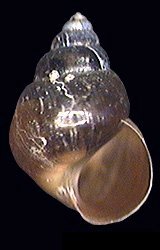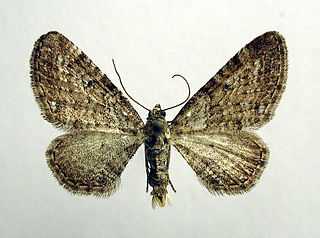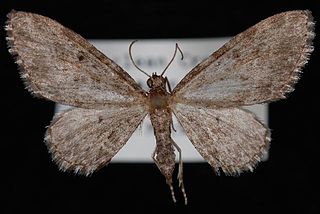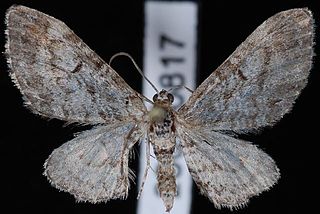
Eupithecia is a large genus of moths of the family Geometridae. There are hundreds of described species, found in all parts of the world, and new species are discovered on a regular basis.

The lime-speck pug is a moth of the family Geometridae. It is a common species throughout the Palearctic region, the Near East and North Africa.

The common pug(Eupithecia vulgata) is a moth of the family Geometridae. It is a common species across the Palearctic region, the Near East and North Africa. It ranges from the Atlantic coast of Ireland and Portugal across Europe, the Middle East and Central Asia to the Russian Far East (Priamurje) and Korea.

The juniper pug or juniper looper is a moth of the family Geometridae. The species was first described by Michael Denis and Ignaz Schiffermüller in 1775. It is found throughout the Palearctic and Nearctic regions and the Near East.

Assiminea is a genus of minute, salt-tolerant snails with an operculum, aquatic gastropod mollusks, or micromollusks, in the family Assimineidae.

Eupithecia innotata, the angle-barred pug, is a moth of the family Geometridae. The species was first described by Johann Siegfried Hufnagel in 1767. It ranges from Spain in the west to western Siberia and Central Asia in the east.

The larch pug is a moth of the family Geometridae. The species can be found in Europe, the Ural Mountains, West and Central Siberia, the Altai Mountains, Transbaikalia, Yakutia, the Far East, Mongolia, Korea, Japan and in North America, from Yukon and Newfoundland to New York and Arizona.

Eupithecia simpliciata, the plain pug, is a moth of the family Geometridae. It is found in the Palearctic ecozone, from western Europe to north-western China (Xinjiang).
Hackelia brevicula is a species of flowering plant in the borage family known by the common name Poison Canyon stickseed.

Eupithecia venosata, the netted pug, is a moth of the family Geometridae. It was first described by Johan Christian Fabricius in 1787. It is found across the Palearctic ecozone from Portugal and Morocco in the west to the Lake Baikal in Siberia and Afghanistan and Pakistan in the east.
Littorina brevicula is a species of sea snail, a marine gastropod mollusk in the family Littorinidae, the winkles or periwinkles.

Eupithecia pernotata, or Guenée's pug, is a moth of the family Geometridae. The species was first described by Achille Guenée in 1857. It is known from the Alps, through Romania to southern Russia. It is also found in Finland.
Turbonilla amoena is a species of sea snail, a marine gastropod mollusk in the family Pyramidellidae, the pyrams and their allies.

Eupithecia quadripunctata is a moth in the family Geometridae. It is found in India, Pakistan, Nepal, Russia, China, Taiwan, Korea, Japan and northern Thailand.
Eupithecia variostrigata is a moth in the family Geometridae. It is widespread in the western Palaearctic, ranging from Spain to the western Pamirs in the east.

Eupithecia silenicolata is a moth in the family Geometridae. It is found from southern Europe and Morocco to western Asia, Iran and Pakistan. In the north, the range extends to southern Switzerland, Austria and northern Italy.

Eupithecia lachrymosa is a moth in the family Geometridae first described by George Duryea Hulst in 1900. It is found in North America from central Saskatchewan west to southern Vancouver Island, north to British Columbia and Alberta and south to California.

Eupithecia graefi, or Graef's pug, is a moth in the family Geometridae. The species was first described by George Duryea Hulst in 1896. It is found in North America from south-western Alberta west to Vancouver Island, north to Alaska and south to California. The habitat consists of wooded areas.

Holcaspis brevicula, the Eyrewell ground beetle, is a species of carabid beetle native to New Zealand, one of a number of small black flightless beetles in the genus Holcaspis that inhabit the dry eastern lowlands of the South Island. H. brevicula is very rare—only ten specimens have ever been collected—and critically endangered: the species was found only in Eyrewell Forest, a single plantation of exotic pine trees currently being converted into dairy farms.
Melanopsis brevicula is a small species of gastropod endemic to small streams near Agourai, Morocco. It is distinctive due to its minute size, flattened sculpture, low spire, and small aperture. It is known from a single location 10 km2 in area(Oued Ain Maarouf) which has been well surveyed, and found to be threatened by increasing human population, droughts of increasing extremity, water diversion, and pastoralization. Shell collecting presents a minor threat to populations. The species has been classified as Critically endangered by the IUCN.













